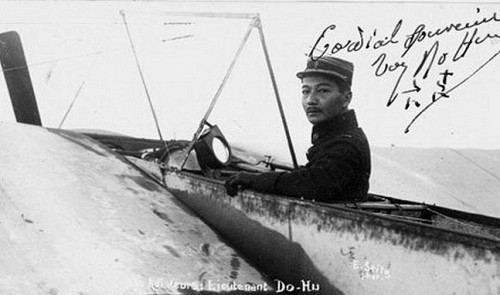On the dawn of aviation in the early 20th century, a Saigonese pilot earned the world’s respect with his heroic service to France’s air force during World War I.
As France commemorated the 100th anniversary of the Battle of the Somme during World War I last year, French television aired the rarely seen archives of Vietnamese military men who served in the war.
Among those featured in the program was Do Huu Vi, a Vietnamese man with a great, soldierly mustache who appeared time and time again in photos among French officers, flying planes, and riding horses.
His name and portraits are also featured on French postcards and commemorative stamps as a tribute to his honorable sacrifice during the war.
The special son of Viceroy Phuong
Do Huu Vi was the fifth of Viceroy Do Huu Phuong’s eleven children. Phuong was widely considered among the four wealthiest men in southern Vietnam during the late 19th and early 20th century.
Born in 1883, Vi, like his brothers, was enrolled in dominantly French schools in Saigon during his youth due to his father’s keen interest in French culture.
After finishing collège (the French equivalent of secondary school) in Saigon, Vi traveled to Paris to attend high school at the Lycée Janson de Sailly, where he quickly became “more French than a French citizen.”
Vi graduated in 1904 and decided to apply for the Special Military School of Saint-Cyr, a highly regarded French military institute founded in 1802 by Napoléon Bonaparte as a training ground for France’s most decorated military officers, including General Philippe Leclerc, commander of the French Far East Expeditionary Corps.
After spending two years at Saint-Cyr, Vi graduated from the academy as an under-lieutenant in the First Legion, participating in France’s battlefronts in Algeria and the Moroccan cities of Oujda and Casablanca.
By the end of 1910, Vi had enlisted in the L’école Militaire de Pilotage, where he would be trained as a military pilot for the newly-formed French Air Force.
His enrollment was admired as a bold move. At that time the global aviation industry and national air forces were still in their infancy and few safety measures were in place. In fact, so few measures were in place that Vi nearly died in a plane crash that resulted from his malfunctioning Cauldron airplane 300 meters above the ground.
In 1911, Vi was the first Vietnamese pilot to circle France by plane in a cross-country flight he made with his French co-pilot Victo Ménard.
The celebrated pilot returned to Vietnam in 1914 and became a stunt pilot, performing in both Hanoi and Saigon, later becoming one of the first Vietnamese to operate a French-made motorboat powered by plane engines.
Though he was earning more and more recognition throughout the country, Vi’s homecoming was cut short when he was summoned back to the French Air Force in 1914 to fight alongside his older brother Do Huu Chan in World War I.
Vi’s fearless pilot skills earned him great respect within his division, and then he was quickly promoted to second-in-command of a bombing squadron.
Finding himself at home in both Vietnam and France, Vi was remembered by his fellow military men with a famous quote: “I must be twice as brave, for I am French and Vietnamese.”
For honor
At the height of the the war in 1915, France was suffering heavy losses and, in the chaos of warfare, Do Huu Vi’s plane crashed after flying into a fierce storm.
Vi miraculously survived the crash, though the accident left him severely injured. He was left unconscious for nearly ten days with a broken arm and fractured jaw bone.
Though his injury qualified him for dismissal from service as a war invalid, the man refused to allow his injuries to dictate his career and chose to continue serving his unit as a captain.
He was later given command of a company of 300 soldiers during the Battle of the Somme, the largest battle to take place on the Western Front in the First World War and a tradgedy which left more than one million men wounded or killed.
It was during this battle that the brave Vietnamese man lost his life during an ambush on a German trench between the northern French communes of Belloy-en-Santerre and Estrée.
Do Huu Vi drew his last breath on the battleground around 4:00 pm July 9, 1916 at the hands of the German army.
The Vietnamese hero was buried in the French commune of Dompierre on the bank of the Somme. His remains were returned to Vietnam four years later on a transoceanic ship.
Attended by top French officials with great admiration for the Vietnamese captain and his sacrifice for France, Vi’s funeral was one of the biggest Saigon had ever seen.
























































